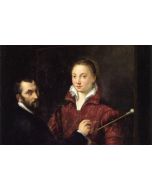Costume and fashion in art

- Course Code: VB978
- Dates: 22/04/24 - 03/06/24
- Time: 10:30 - 12:30
- Taught: Mon, Daytime
- Duration: 5 sessions (over 7 weeks)
- Location: Keeley Street
- Tutor: Julie Barlow
Course Code: VB978
Duration: 5 sessions (over 7 weeks)
Please note: We offer a wide variety of financial support to make courses affordable. Just visit our online Help Centre for more information on a range of topics including fees, online learning and FAQs.
What is the course about?
This course explores the important role played by costume and fashion in the creation of personal and public identity, both male and female. Exploring European art since the Renaissance we will decode and decipher the messages and meanings intended through the choices made by artists and sitters about dress. A portrait is rarely just a portrait, it is a window onto a world, the requirement of the court artist, for example, from Hans Holbein to Annie Liebovitz has always been to convey power, status and to inform us about court etiquette. It is through costume that these messages can be conveyed most clearly.
Costume is also carefully employed by painters in other subject matter, in religious commissions and in mythological subjects by artists as diverse as Jan van Eyck and Titian as a way to help the viewer identify both individual figures and their place within the narrative.
We will also study changes across time, in the availability of pigments, materials and dyes. The Industrial Revolution revolutionised not just means of production, but the advent of mass production brought new choices in fashion to those lower down the social strata. In more recent times, choice of costume or of fashion designer, continues to be significant, the slogan on a t-shirt worn by a famous sitter in a portrait photograph is as powerful today as the crown worn by a monarch in a coronation portrait of the past.
The final session of this course will take place at the National Portrait Gallery.
What will we cover?
• Individual works of art across 500 years of European painting
• Fashions from different periods and how to date a portrait through the costume worn by the sitter
• How to place paintings within a broad social, political and economic context
• Key individual portrait painters and photographers.
What will I achieve?
By the end of this course you should be able to...
• Understand the significance of costume and fashion in art
• Give at least 3 examples of significant costume as depicted by leading portrait painters from different centuries
• Identify how choices in costume change as a result of broader moments of change such as developments in international trade in the 17th century and technological advances in the 19th century.
• Discuss key features of costume design across time giving and be able to explain the importance of at least two examples.
What level is the course and do I need any particular skills?
This course is suitable for all levels.
You should be able to follow simple written and verbal instructions, demonstrations, hand-outs and health and safety information.
How will I be taught, and will there be any work outside the class?
You will be taught by lecture with slide images and you will be invited to participate in group discussion. There will be handouts provided by your tutor; these handouts will be available digitally via a Google Classroom. You will be invited to join the Google Classroom within a week of your course start date.
The final session of this course will take place at the National Portrait Gallery in London. Offsite sessions take place during public access hours. Tutors are not able to control sound levels or behaviours of visitors outside of the course group, gallery closures or fire alarms. Unless you are a wheelchair user, and have confirmed access details with us (as levels of access can vary between buildings), you will need to be able to walk between sites and stand for some time while looking at them (you may bring your own portable stool if you have one, but we cannot guarantee access to seating offsite.) If you feel you may be impacted by these environmental variations, please inform the department on humanities@citylit.ac.uk before the course begins, to discuss reasonable accommodations we can make to assist your learning in offsite.
Are there any other costs? Is there anything I need to bring?
You might wish to purchase a notebook for taking notes. You might wish to buy some of the books on any reading list given out in class.
When I've finished, what course can I do next?
You might also be interested in:
Art and Culture in 17th Century London
Textiles: an international history.
Julie Barlow has a degree in Art History/History from the University of Hull and an MPhil (Fine Arts) from the University of Birmingham. She has worked in a variety of roles at Leighton House, V&A and Tate Gallery before studying for a PGCE and moving into Museum Education. Julie has over twenty years of experience as a freelance lecturer at the National Portrait Gallery working on all areas of the Education Programme and also for the first ten years at the National Gallery and in the last decade at the Wallace Collection.
Please note: We reserve the right to change our tutors from those advertised. This happens rarely, but if it does, we are unable to refund fees due to this. Our tutors may have different teaching styles; however we guarantee a consistent quality of teaching in all our courses.
